
The Award Winning
Monthly Newsletter of the Anchorage Coin Club
Volume 14, Number 7 July, 2001
July Membership Meeting:
There Will Be No Membership and YN Meetings for the Month of July
See You At Our Club's Summer Picnic at Centennial Park on August 11th
INSIDE:
The YN Corner
"So You Want to Hoard Coins? Here Is A Suggestion"
"They Only Made 8 Million Of These?"
FROM YOUR EDITORS
It is the height of summer with sun up until 11:30
p.m. then up again just a few hours later, with fish running up rivers,
people running up mountains and none but the serious collectors showing
up to coin club meeting. Those who came to the June meeting were
treated to Mark Nagy’s presentation on the numismatic industry - a serious
look at collecting coins. We learned serious things about getting
coins through the mail and about easily obtainable coins destined to become
serious keys in the near future.
Members also had an opportunity to buy serious error coins in
the bullet auction. Steve Mead, up from Pittsburgh. brought the serious
coins such as the dual denomination cent (a cent struck on an already struck
dime), and the quarter with the obverse off center and reverse centered.
Ancient coins and books were also in the bullet auction. One book
was Paper Money of the United States.
Many of our members had other serious things to do; for instance
those who braved the Sterling Highway to get to the Russian River
to join the fishing crowd. They caught salmon. Then there was
Cory Rennell who braved 4000 miles to join the NAFTA rioting crowd in Quebec
City. He caught a nose full of tear gas.
Meanwhile back here at the meeting we gave Justin Samorajski a BU 2000
Silver Eagle for the membership prize and Roy Brown won the door prize,
a 1999 Cruise Alaska Silver Medallion from the Alaska Mint. The summer
picnic was scheduled for Saturday August 11th at Centennial Park.
And Greg, Loren, and Richard agreed to man a display table advertising
our club at the Denali Federal Credit Union’s annual membership appreciation
picnic on June 29th at 3400 LaTouche. Members of that credit union
are heartily invited to join us.
The biggest event of the summer was Larry’s glorious, eucharistic marriage
to Maribel at the Holy Family Cathedral followed by the gala wedding reception
at the down town Hilton. The smiling couple is now off to a honeymoon cruise
down the Mexican Riviera. We are looking forward to the pictures.
They are looking forward to a happy life together….Your Editors.
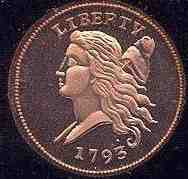 |
1793 Half Cent/ Obverse
MEMBERSHIP NEWS
Schedule of Events for the Month of July
-
Monthly Membership Meeting: Since the lst Wednesday of July
is the 4th of July, there will be no membership meeting in July. Enjoy
your fishing and summer escapades.
-
YN (Young Numismatist) Meeting: There will be no YN meeting
for the month of July. Enjoy the summer.
-
Anchorage Coin Club Board Meeting: July 18th (Wednesday) 7:00 PM
at the Central Lutheran Church. Our club’s summer picnic details will be
the agenda. Club members welcomed.
Minutes of the June 20th Board Meeting
The board meeting was called to order by President
Bill Hamilton at 7:10 p.m. with the arrival of John Larsen giving us a
3 man quorum. Bill, Loren, and John discussed ways to help the club’s
bank account. The first suggestion was a nominal fee for sodas and
chips; just enough to cover cost. Another was a nominal fee to put
coins in the bullet auction; 1 or 2 dollars would buy a member a log sheet
with which they could put any number of coins in the auction. Greg
showed up to the meeting and pointed out how little these measures would
save the club and that our membership fee is for covering such things.
Bill pointed out that our club is paying for an insurance policy to
cover accidents that may happen at a coin show and that we should
collect something from coin shows that make use of that policy (everyone
putting on a show should have this coverage). We also agreed that
the club should be putting on coin shows not only to use the insurance
policy that we pay for, but to make money for the club. It would
take a dedicated team to put on coin shows.
Bill suggested putting a small table in a mall with a coin club flag
overhead. Members would man the table just to answer coin questions
and give out membership applications. We could move the table and
flag round to different malls, educate people about our club, and generate
new members. There would be no fixed hours and since the only thing
we are selling is club membership the setup would be very portable.
Greg suggested we sponsor coin seminars for the general public.
This would help educate the public so they would be more likely to go to
our coin expo in 2003. It would allow us to practice putting on large
coin events in preparation for the coin expo and it would give the club
an opportunity to make money. Loren thought the first step
is to find a place to have it. Bill suggested the Ship Creek Mall
in front of his shop. Greg said he would look into facilities at
UAA. There was some discussion of the expertise we have in the club
on certain aspects of coin collecting; people we could call on to make
presentations at this seminar.
Greg asked what the plans were for programs at coin meetings in the
coming year. Bill said we will continue with his tenet of basic coin
education and pointed out that Mark Nagy is doing a great job of bringing
ANA programs to the membership meetings.
Since the first Wednesday of July is the 4th and due to fact that people
are hard enough to put into a small room in the summer it was decided to
not have a meeting in July and welcome everybody to the summer picnic Saturday
August 11th at Centennial Park.
With no further business or suggestions the meeting adjourned at 8:20
P.M.
THE YN CORNER
By the time you receive this newsletter, YN Corey
Rennell will be on his way to Colorado Springs to attend the ANA Summer
Conference. Corey will be there for one week and you can expect a report
from Corey in our club’s next newsletter. Thanks go to Mike and Michelle
Robuck of the Alaska Mint for sponsoring Corey’s trip to the ANA Summer
Conference.
Meantime, we did have a YN meeting on June 8th.
The meeting ended up being a session on U.S. paper currency and it’s
history with Larry Nakata displaying his collection of one dollar notes.
YNs who attended the meeting got a chance to see all of the different types
of U.S. one dollar notes from the time of our country’s revolution to today.
And….they got a bit of a history lesson on how our country’s paper currency
evolved over the years. Everything from Continental currency to State Bank
notes to Confederate & Federal currency were shown that evening. And,
of course, there was lots of pizza and soda pop for the YNs and their families
to enjoy.
I want to remind all YNs that there will be no YN meetings for the months
of July and August. However, all YNs and their families are invited to
our club’s summer picnic planned for Saturday, August 11th at Centennial
Park/Anchorage starting at 12 noon. Lots of food, games, fun, and coins
to see & trade. So come and have a good time……Larry Nakata.
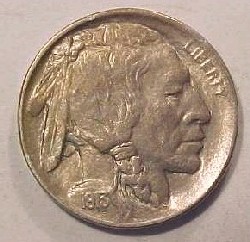 |
1913 Buffalo Nickel/ Obverse
SO, YOU WANT TO HOARD COINS?
HERE IS A SUGGESTION by Mike Nourse (Member# 94)
Hello to all you coin hoarders out there! Yes,
I know there are some of you out there, trying to buy up all of the available
supply of one or several coin issues. You will not see very many articles,
especially positive articles, about how to hoard coins. My point of view
is that if you have chosen coin hoarding as your method of collecting,
have fun with it and good luck making some profit in your endeavor.
Most individuals who chose to hoard a specific issue are doing so with
the hope of accumulating a sizeable percentage of the surviving coins,
thereby moving the price higher because so many coins are now off the market.
In general you can either focus on a common issue, in which you have to
buy a lot of coins but each one is quite inexpensive, or you can look at
a much scarcer issue where you have many less coins to buy but each one
will set you back a not insignificant amount of money.
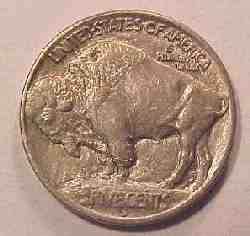 |
Type I Buffalo Nickel/ Reverse
For example, you may choose to focus on 1945 mercury dimes. You can
purchase just about as many as you could ever want for one dollar or less
in average circulated condition, but it will take a huge quantity of them
before you actually own a material percentage of the surviving coins. On
the other hand, if you decided to hoard 1857 large cents, there are far
fewer of them in existence and not many on the market at any one time.
However, they will run from $20 to $75 each for circulated coins.
So, what about my suggestion? Kind of right in the middle. With
a coin that is too common, like the above mentioned 1945 mercury dimes,
there are just so many around that an individual could never hope to get
enough of them to really dry up the available supply. Otherwise, something
else like 1844 seated liberty dimes, will deplete a typical person's funds
in short order at $150 to $850 for circulated specimens.
My suggestion for hoarding would be your choice of any of the mint marked
issues of buffalo nickels from 1913 type two through 1919. I think any
of these fourteen issues would be an excellent hoarding candidate, and
here is why. Mintages are moderate, not so low that they attract attention
as key dates, but not so high that the market is flooded with these coins.
Values, too, are moderate, generally ranging in the lower circulated grades
from about five to fifteen dollars a pop up to as high as $150 in higher
circulated grades.
Often, part of the reasoning behind hoarding is to cause a coin to appear
more scarce than it really is, thereby causing a price rise. A price rise
really does not help much if the coin you hoarded has limited demand. Therefore,
it is essential that the hoarder focus on a coin that is in heavy demand.
And buffalo nickels fit the bill well in this department. Their design
is one of the best recognized and most famous of all American designs.
If you don't believe me, ask almost any non collector if they are familiar
with the buffalo nickel and you will almost always receive an affirmative
response. Try the same question using the Liberty head or shield nickel
and you can expect a blank stare. Buffalo nickels are very heavily collected
by both beginning and advanced collectors.
We are all familiar with the propensity of the date to wear off buffalo
nickels with startling rapidity once they enter circulation. This caused
a substantial percentage of the original mintage of the early date buffaloes
to lose their dates to become merely the ubiquitous dateless buffaloes
which are readily available by the bag. Some people restore the dates of
these nickels using chemicals that are readily available, but these coins
should only be purchased if they are available at a huge discount to the
Good price. Similarly, beware of buffalo nickels advertised as a scarce
date which have so much of the date worn away that it is difficult to tell
if it really is the date which you are purchasing.
Can you make a profit hoarding these nickels? Quite possibly. These
coins do not fly up in value but they seem to steadily crawl on up, and
rarely dip down. Once the value increases to a level such that you wish
to cash out, this too would be no problem. Go to most any dealer of any
size with a group of early mint marked buffaloes and they will eagerly
purchase the whole lot. These coins just do not walk through the front
door very often, and they are easy sellers. You just do not find dealers
who are overstocked in these items, particularly in the average collectable
grades of Good through Very Fine.
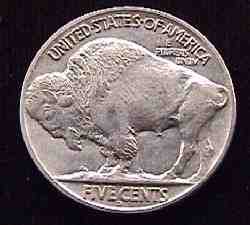 |
Type II Buffalo Nickel/Reverse
So, to summarize, the early mint marked buffaloes make excellent
hoarding candidates because:
1) Original mintages are low, but not so low that they attract lots
of attention as key dates. For several of the dates, the entire original
mintage would fit in a small closet.
2) Survivorship is very low. The dates wore off buffalo nickels very
quickly and their heavy use in circulation means that these just no longer
exist by the truckload.
3) They will not cost you a fortune on a per coin basis, at least not
in circulated grades.
4) When the time comes to dispose of your hoard, the popularity of these
coins combined with an almost universal need among dealers to get more
of them in stock means that you will be able to sell quickly and at a fair
price without much difficulty.
There are not too many coins that make good hoarding candidates, but
these fourteen early mint marked buffalo nickels seem to have many of the
attributes that a person should be looking for. So if hoarding is your
game, consider these early buffaloes for some potential profits….Mike
Nourse.
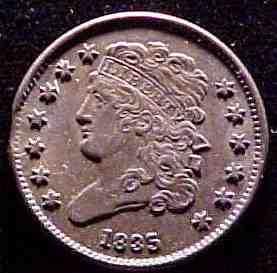 |
1835 Half Cent/ Obverse
THEY ONLY MADE 8 MILLION OF THESE?
by Mike Nourse (Member# 94)
In modern times, where mintages of regular issue
circulating coins are usually in the hundreds of millions, if not over
one billion, we have to look way in the past to find mintage numbers of
only eight million. But wait, I am not focusing on a single issue that
had a mintage of only eight million, I am looking at an entire denomination,
the United States half cents.
Half cents were minted during a span of 65 years from the beginning
of the mint in 1793 through 1857 when they were discontinued in the same
legislation that outlawed the circulation of foreign coinage. With the
elimination of bits (12 ½ cents) from our monetary system there
was no longer a need for the half cent. They did not get used in commerce
very much anyway and were not terribly popular with the public. Due to
this low demand there was not a great need to produce the half cents in
huge quantities. In fact, every time the mint tried cranking out a large
number of half cents, they ended up with a great oversupply that took years
to get rid of. Hence, there were a number of years with no production at
all while the previously minted stock was used up.
We know that in 20th century terms, eight million coins produced for
circulation over the course of 65 years is miniscule, but how did it stack
up back in those days? The closest comparison would be the other copper
coin of the day, the large cent. Over that same 65 year span, there were
a whopping 155 million large cents made, or 19 times as many as half cents.
The public just did not have as much use for the half cents. A number of
half cents even went to the melting pot so that their copper could be used
to mint the large cents.
There are five major designs for half cents. The flowing hair design
of 1793 saw only 35 thousand pieces made, the liberty cap design of 1794
through 1797 saw only ten times that quantity, 350 thousand. Increasing
again by ten times to 3.5 million gives the approximate mintage of draped
bust half cents of 1800 to 1808, and, coincidentally, the same 3.5 million
number is used again for the classic head design from 1809 through 1836.
Production then dropped to 545 thousand for the braided hair design from
1840 to 1857.
For the ultimate in rarity, look no further than the Proof half cents
with a grand total of 1,259 pieces produced. This consists of a lonely
192 classic heads along with 1,067 braided hair coins. This is a land in
which original mintages are generally stated with two digit numbers and
survivors can fit in one hand. Hmmm, sounds like something to explore in
a future article.
How best to collect half cents? Realistically, a five piece type set
is the only method available to the average collector. A one a year set
is a reasonable goal for the 1800 through 1857 years (ignoring the proof
only years), but the very rare 1796 will require a high four digit outlay
keeping it out of the reach of most of us. Even the five piece type set
will empty the average wallet, primarily because the 1793 flowing hair
half cent commands $1425 or thereabouts in Good condition. The other four
types are much more reasonable although the liberty cap design is by no
means cheap. If you just want a half cent, any half cent, $30 will get
you a specimen in Good, although $45 for a Fine is a better value in my
opinion.
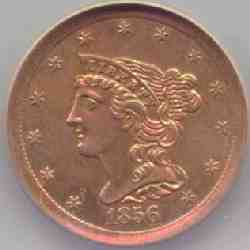 |
1856 Half Cent/ Obverse
We all know that just under eight million half cents were produced,
but we do not know how many are still here in the 21st century. Of course,
most of them are gone, but I would not be surprised if three percent (250,000
pieces) are still around today. However, if that number is somewhat accurate,
I would say that 100,000 of them have been truly thrashed via bending,
holing, buffing, whizzing, or turned into jewelry. An additional 100,000
would have taken a milder beating, mostly in the form of heavy dings or
a cleaning. I really doubt that any more than 50,000 coins remain in nice
uncleaned, undamaged condition. Even the Proofs, which were supposed to
be well cared for by knowledgeable numismatists, probably do not number
more than 500 by now after eliminating cleaned specimens. And I think that
even these numbers may be overly optimistic.
If there are not that many remaining, how can they be available for
only around $30? Simple. Demand is quite limited because half cents do
not show up at the top of the popularity list. They are heavily overshadowed
by the large cent, which is much more readily available, generally less
expensive, has more interesting varieties, and has had more books written
about it. Also, a truly complete set is not realistic since a number of
the dates are super rare Proof only issues, which require horrendous amounts
of cash to acquire on the infrequent occasions that one becomes available
for sale. Even type set collectors seem to put off the half cents until
last, preferring to focus first on the higher denominations.
Are half cents a good investment? Probably they are, but you are not
likely to get rich quick with them. The key is to only acquire those few
uncleaned, untampered pieces. It is not unusual that when you look through
a dealer's inventory you will find many pieces that have seen some form
of abuse over the years along with very few original pieces. The original
ones cost more of course, but these are the ones that will increase in
value and always be very easy to sell for a fair price. In my 27 years
of buying and selling coins, I doubt that I have ever had more than twenty
five or so half cents at any one time, and never more than one Proof at
a time.
So, here is a coin that saw limited original production, has low survivorship,
is over 140 years old, and is an odd denomination. Consider picking up
a few original pieces along the way. You will find that it is not as easy
as you may think to find them!…Mike Nourse.
The Anchorage Coin Club
Club Officers
-
President - Bill Hamilton - Days: (907) 277-6110
-
Vice President - John Larson - Eves: (907) 276-3292
-
Treasurer - Greg Samorajski- Eves: (907) 346-3240
-
Secretary - Larry Nakata - Eves: (907) 563-1729
Board of Directors
-
Roy Brown - Days: (907) 563-6708
-
Corey Rennell - Eves: (907) 563-6459
-
Loren Lucason- Eves: (907) 272-3700
Editors
Larry Nakata / Mike Nourse / Jim Susky / Loren Lucason
Club Archivist/ Photographer
Robin Sisler
DUES
-
Life Membership $250
-
Regular Membership $25/year
-
Associate Membership $10/year
-
Senior/Disabled $10/year
-
YN (Junior) Membership $5/year
To save costs, members not responding to renewal notices within 3 months
will be considered inactive.
The Anchorage Coin Club is a non-profit organization formed to provide
information, education, and a meeting place for individuals having an interest
in numismatics.
Correspondence Address: Anchorage Coin Club, P.O. Box 230169, Anchorage,
Alaska 99523
Return to: "Top of the Newsletter"






